|




Translated
with permission from the creator, Lien at
X-clusive Designz tutorial site.
 


See the original
tutorial here for PSP in Dutch
 
They will both open
in a new window and print out on standard 8½" X
11" paper
For
information about which fonts, programs, etc I
used to construct my pages and my headers,
click
here.
|
For this tutorial you will
need:
 or or 
I've done this
tutorial in PSP 9 and PSP XI.
I believe it
can be done in most versions.
You may have
to look around for the commands but it's likely
they are there.


Filters and
materials needed
No filters
needed
Supplies in zip file here.
Supplies in zip file here
for older versions if the other ones don't work
for you. These are in psd format.
From
Lien: Important!!! Please read
carefully!!!
* The scrap tubes used in
this tutorial are bought by me personally. You
may use these scrap elements for this tutorial,
and for your personal use. You may not offer
these tubes for sale, trade, sharing, your own
tutorials, or commercial purposes.
Read
carefully the conditions of the scrap designers.
If this rule is not observed I will have to stop
writing scrap tutorials!!!
Thanks for your
cooperation.
Concentration tube misted
by Sugar


I am assuming
you know the basics of Paint Shop Pro and where
the tools can be located. |
Here are some
arrows and bars you can drag and drop where you
need to mark or underline where you are. .
Just left click and drag to where you want
it then let go.
They will stay where you put
them until you close your browser.
       

 |
Either install the font or
double click to open the windows font viewer for
it.
Leave it open and it will be available
in PSP.
Open up your tubes and pattern file.
Minimize all till needed.
Each tube is only
used once so you can close the tube files as you
use them. |
Step 1
Open a new
transparent image 640 x 480 pix. |
Step 2
Activate the tube
LG-mem-rightside - copy (control-C), go to your
working canvas,
paste as new layer
(control-L). Move the tube entirely to the
right.
 |
Step 3
Activate the tube
LG-mem-leftside - copy (control-C), go to your
working canvas,
paste as new layer
(control-L). Move the tube entirely to the
left

Layers>Merge down
(don't flatten or merge visible) |
Step 4
Activate the tube
LG-mem-background - copy (control-C), go to your
working canvas,
paste as new layer
(control-L). Move the tube a little to the left
as shown.
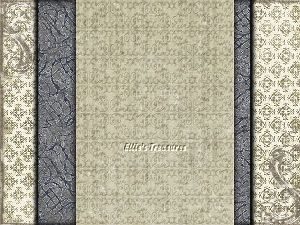 |
Step 5
Activate the tube
LG-mem-lace - copy (control-C), go to your
working canvas,
paste as new layer
(control-L). Move the tube to the left side of
the left grey-blue strip, as shown
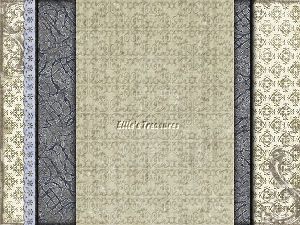
Layers>Duplicate

Image>Mirror and move
the tube to the right edge of the right grey
blue strip
Layers>Arrange>Move down,
then move the lace on both sides till it's just
peeking out
from behind the background tube.
Do the same with the lace on the other
side.
See my example. It's a bit hard to see
along the right side, but it matches the
left.
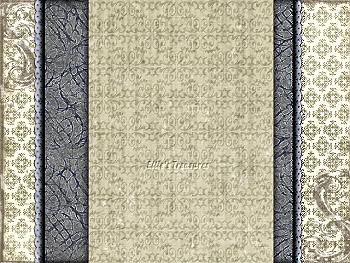

Here's a closeup

Highlight the top lace
layer Layers>Merge>Merge down so both lace
pieces are on one layer. |
Step 6
Activate in your
layer palette the upper layer.
Activate the
tube LG-mem-stitches1 - copy, go to your working
canvas, paste as new layer (control-L)
Move
it to the right side of the left blue tubes edge
according to my example.
Layers>Duplicate. Image>Mirror. The
tube will go to the other side, move it into
place if it isn't quite right.
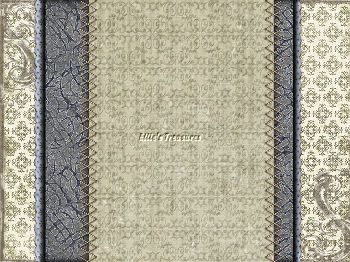
Layers - merge
down |
Step 7
Activate the tube
LG-mem-tag - copy (control-C), go to your
working canvas, paste as new layer
(control-L)
Move the tube so it almost
touches the bottom edge.
 |
Step 8
Activate in your
layer palette the upper layer.
Activate the
tube LG-mem-stitches2 - go to your working
canvas, paste as new layer (control-L)
Move
it to the left side of the left blue edge
according to my example.
Layers>Duplicate. Image>Mirror.
It
will now be on the other side, move it into
place if it isn't in the right spot, see my
example

Layers - Merge
down |
Step 9
Activate the tube
Concentration - copy (control-C), go to your
working canvas, paste as new layer
(control-L)
Move it up a bit, as shown
here.
 |
Step 10
Activate the tube
LG-mem-frame - copy (control-C), go to your
working canvas, paste as new layer
(control-L)
Move it up so it frames the
concentration tube, see example.
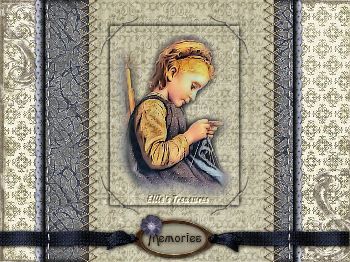 |
Step 11
Activate the tube
LG-mem-heart - copy (control-C), go to your
working canvas, paste as new layer
(control-L)
Move the tube to the right as
shown.
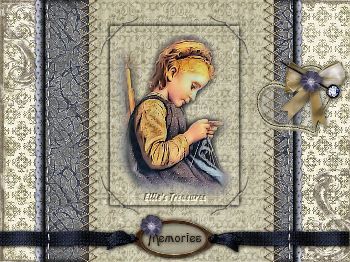 |
Step 12
Activate the tube
LG-mem-corner - copy (control-C), go to your
working canvas, paste as new layer
(control-L)
Move the tube to the left top
corner as shown. Place it so the
flat edges
at the top and left are just touching the
edge.
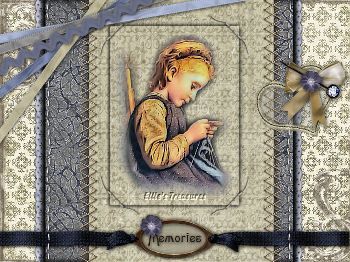 |
Step 13
Activate the tube
LG-mem-flowertag - copy (control-C), go to your
working canvas, paste as new layer
(control-L)
Move the tube to the upper left
corner as shown.
Activate the raster deform
tool. Change the mode to Free (shift). You will
see the red boxes around the tube.


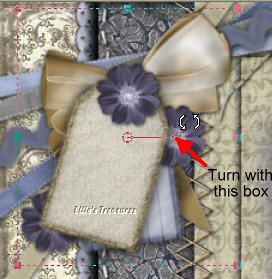
Hover with your cursor
close the middle right where the red box sticks
out of it, on a line.
You will see curved
arrows. Click down there and holding the left
mouse button down,
turn the tube slightly up
anti-clockwise (up)

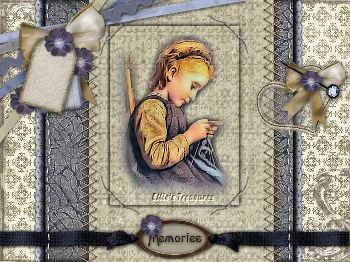 |
Step 14 - Adding text
Layers
- new raster layer.
Activate the text tool
and pick the font Agatha (in zip). Use a size
that would fit your text on the tag
(I used
size 22), foreground color set at null,
background color #282116 (almost black),
make the text as a vector, so that you can
rotate the text on the tag.



If your text is on two
lines, it's better to do them separately so you
can move them closer together.
If you just
go down one line in the same text window and
type the next line,
you'll see that the two
lines of text are quite far apart.

Activate your raster
deform tool, Free mode, and rotate the text up
on the right side, counterclockwise, in
alignment with the tag.
Effects>3D
Effects>Drop shadow. H+V = 1, opacity = 50,
blur = 10, color black.


 |
Step 15
Check if everything
is placed properly.
Layers>Merge>Merge
visible
Image>resize - 90%.
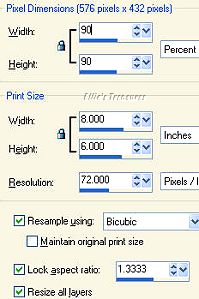

Adjust>Sharpness>Unsharp mask
with the settings: 1-64-4.
 |
Step 16
Image>Add border
- 3 pix, color #f2f0e5 (pale grey)
Select the
edge with your magic wand, tolerance at 0,
anti-alias checked.


Effects>3D
Effects>Inner Bevel. Settings: Bevel 2, 3,
10, 5, 0, 0, 315, 50, 30, white


Effects>3D
Effects>Drop shadow. , same as before.
H+V
= 1, opacity = 80, blur = 5, color black. Repeat
with H+V on -1.

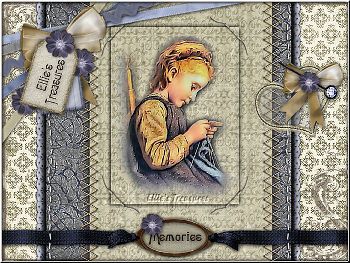
Selections>Select
none. |
Step 17
Image>Add border
- 7 pix, color #3a4353
Image>Add border -
15 pix, color #f2f0e5
Select the edge with
your magic wand.
Open your memory pattern
and find it in your material palette. It will be
at or near the top
Angle 0, scale 100 and
fill selection with the pattern with your bucket
tool.



Repeat Inner Bevel as in
step 16, but change the width to 15.

Effects>3D
Effects>Drop shadow, same as before,
H+V
= 1, opacity = 80, blur = 5, color black. Repeat
with H+V on -1.

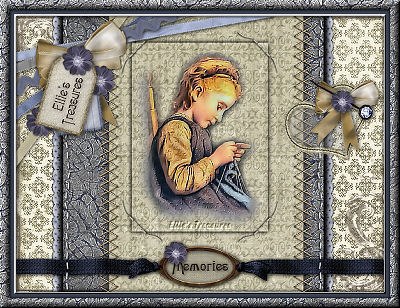
Selections>Select
none

You're done! |
Step 18 -
Watermark
Layers>New raster layer. Add
your water mark on this new
layer
Layers>Merge>Merge all
(flatten) |
Step 19 -
Save
File>Export>Jpeg optimizer -
compression of 20. |
l
hope you had fun!
Back
to top |
| If
you have any questions or suggestions, click on
the email button below to contact me. Have a
wonderful day! |
These tutorials are
translated with permission from the original
writer.
Any resemblance to any other tutorial
is purely coincidental and unintentional.
Feel free to share any of my tutorials on
this site by a link back to my site,
but do
not copy and send the entire tutorial to anyone
or any group.
©2003-2007 Ellie's
Treasures

|
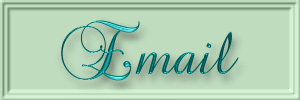

 |
|
Back
to top
Webpage Design
Information
This webpage background was
made in PhotoImpact with a tutorial by Deb
DeHaven
Sadly, she passed away but
her tutorials just came back online, thanks to
PIRCNet.
You can find the tutorial
here.
The font I used for all of
the text on the buttons is BrockScript
The
font I used for the "Memories" tutorial header
is Agatha.
Click on the font name to
download the font.
I use PhotoImpact to make
all of my headers due to the amazing
3D text
it has and the wonderful presets available free
online
Most of the presets I use
are either the ones that come with PhotoImpact,
usually the Gel ones,
or from Deb's PI
Tutorials and More (see below) or
Carol Oyl's
site
This is the address to
Deb's old pages
http://www.fortunecity.com/skyscraper/millenit/1716/pitutorials/objects/presets/presets1.html
I can't find any links to
her new pages but the presets are still on this
page for download.
For more sites to find PI
Presets, take a look at my
Great
Beginnings
page. |